15 Tips On How To Make Vegan & Vegetarian Alternatives To Jewish Foods, According To Micah Siva
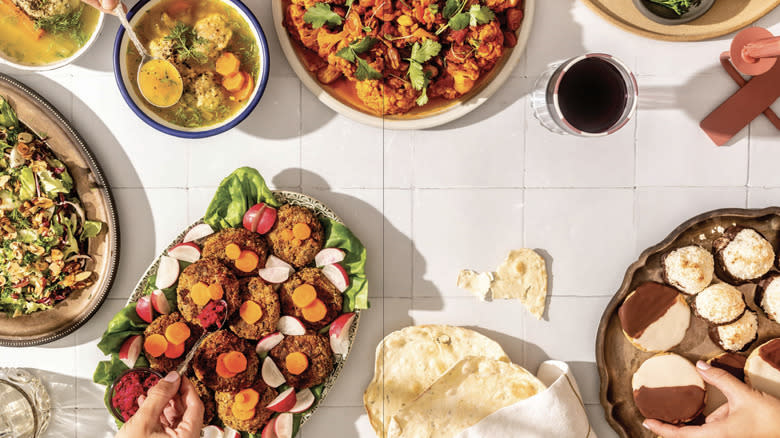
Though many of us will know the comforting sigh of relief and anticipation when sliding into a booth of just about any Jewish American deli across the country, "Jewish food" is not a cuisine in and of itself. Rather, Jewish foods are an adaption of cuisines from around the world. Some dishes will be kept largely the same and adopted into holiday traditions. Others will include adaptations; some changed to adhere to kosher dietary laws that exclude certain items like shellfish and pork products and separate milk from meat; others adapted due to resources and the migration of people across country borders. Adaptions are a large part of food, no matter its origin.
Author and chef Micah Siva couldn't agree more. In her debut cookbook, "Nosh; Plant-forward recipes celebrating modern Jewish cuisine," Siva suggests we embrace the versatility of foods from the Jewish diaspora and the ease of adapting them to suit vegetarian and vegan-leaning eating habits. For those looking to adopt more plant-forward food options, here are tips from Siva, each showcasing recipes from her new book, on how to easily swap in vegetables, legumes, tofu, and tempeh to create tempting dishes from across the Jewish diaspora.
Read more: 23 Types Of Potatoes And When To Use Them
Swap In Heart Of Palm For A Jewish Deli-Style Whitefish Salad
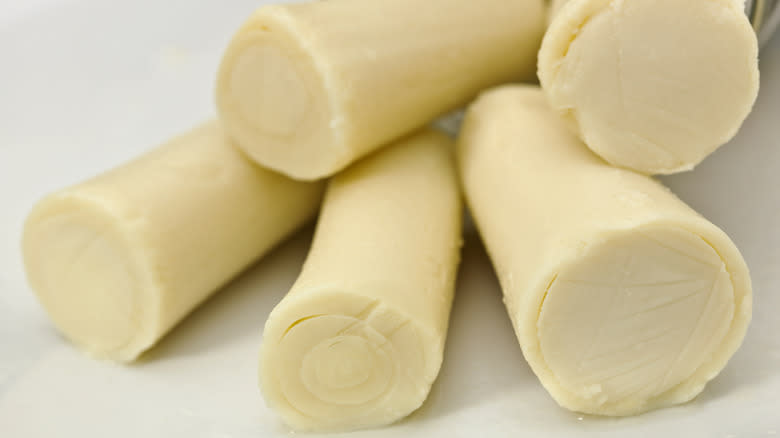
Whitefish salad, which you can typically get at your local Jewish American deli, is typically made from sour cream, onions, celery, herbs, lemon, and plenty of smoked freshwater whitefish such as trout or sable. It is a typical Ashkenazi dish originating from parts of Eastern Europe and Russia, then adapted after Jewish immigrant communities resettled in the U.S. Like the people, the dish adapted, incorporating resources available, like the freshwater fish varieties from the Great Lakes.
Siva says, "If you love ordering whitefish salad at your local deli, try a plant-based version using shredded hearts of palm. Hearts of palm are harvested from the core of certain palm trees. With a mild, briny flavor, they are a great substitute for whitefish, especially when mixed with a dash of liquid smoke. When shredded, hearts of palm become flaky... not dissimilar to fish! Hearts of palm are typically found in the canned vegetable section."
Fill Kreplach With Mashed Potatoes Instead Of Beef
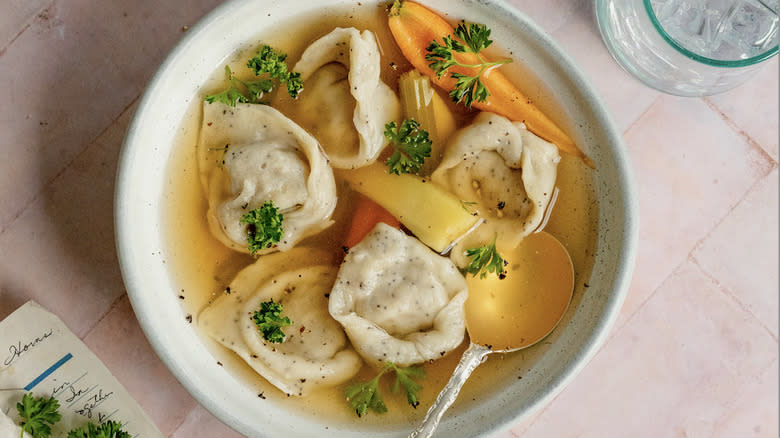
Dumplings are pretty much a universally loved food; they're prevalent in most cultures as a means of using up whatever scraps or leftovers by combining them into a comforting dumpling filling. Kreplach, meaning "dumpling" in Yiddish, originated from the German Jewish diaspora and is now found across many U.S.-based Jewish communities. While this food, often served during Jewish holidays, is typically made with a meat filling, Siva recommends reconsidering a more plant-forward filling that will still satisfy but also lends itself to more vegetarian-based eaters.
She says, "My grandmother would make kreplach using leftover chicken or brisket, but I love to fill mine with mashed potatoes and sweet caramelized onions. Better yet, save your leftover mashed potatoes to fill your soup dumplings with! No potatoes? Try adding your favorite vegetarian meat replacement as well."
Other "meaty" fillings, like earthy mushrooms or lentils, would also be fantastic replacements. Carmalized onions transform a wide variety of plant-based fillings into rich, comforting fillings that can easily replace meat.
Try Jackfruit And White Bean Shawarma Instead Of Chicken
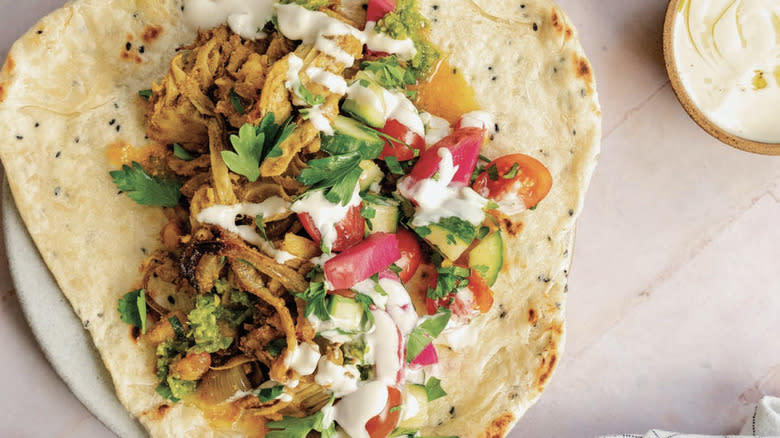
Adapted from the Turkish word çevirme, which means to turn, shawarma refers to the vertically fixed rotating rotisserie method in which spice-marinated and seasoned lamb or chicken is cooked to perfection before being thinly sliced and served in a pita or laffa (a delicious Iraqi flat bread) with an abundance of toppings and dressings including hummus, pickles, and tahini. These meaty, tasty, kebab-like wraps are served across the Middle East, including in the Jewish diasporas from the region.
Siva includes her own version of shawarma in her debut cookbook. She says, "Chicken shawarma is delicious... but you can mimic the taste and texture using jackfruit! Jackfruit is a versatile meat substitute! Jackfruit is a fruit that can be eaten both ripe and unripe. Ripe jackfruit is full of sweet, fruity flavor that reminds me of Juicy Fruit gum, or a mixture of bananas, apples, and mangoes. When eaten under-ripe or young, it is very neutral and can be shredded like meat. You can find young jackfruit in the canned vegetable aisle. With a mixture of both creamy white beans and meaty jackfruit, you'll forget about the meat!"
Stuff Cabbage Rolls With Mushrooms And Kasha In Place Of Beef
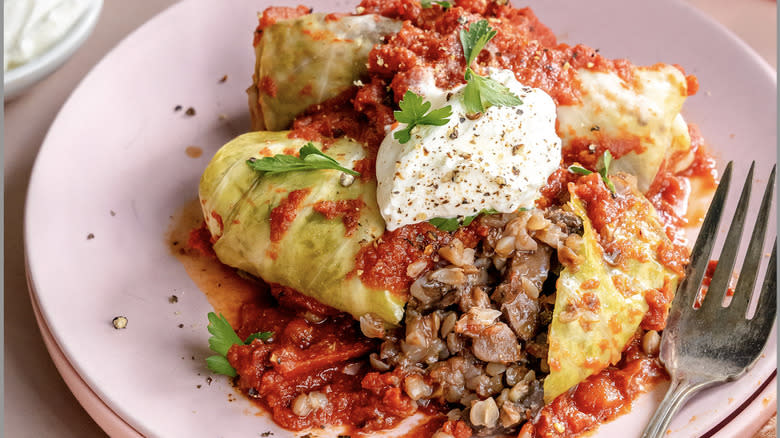
Whether you call them "holubtsi," "gołąbki," or "sarmi," stuffed cabbage rolls are a traditional, comforting dish served across many cultures, particularly in Eastern Europe. Though they tend to be a meaty affair, most commonly served with ground beef within Jewish communities, they can also be altered to appeal to more vegetarian-leaning preferences.
Siva remarks, "Growing up in a Ukrainian household, stuffed cabbage was always on the menu! My grandmother would make hers with beef and rice, subtly spiced, and drenched in a sweet and sour tomato sauce. While hers were delicious, I make mine using a meaty mixture of mushrooms and kasha (or buckwheat) is a delicious way to get stuffed. I add a touch of sweetness with dried cranberries and a rich bite of walnuts."
Buckwheat is so beloved in Siva's household and kitchen that she's affectionately named her dog by the same name. If this isn't encouragement to consider adding this hearty, vitamin-and-mineral—rich grain into various dishes, we don't know what is.
Use Olive Oil In Place Of Schmaltz For Vegetarian Matzo Balls
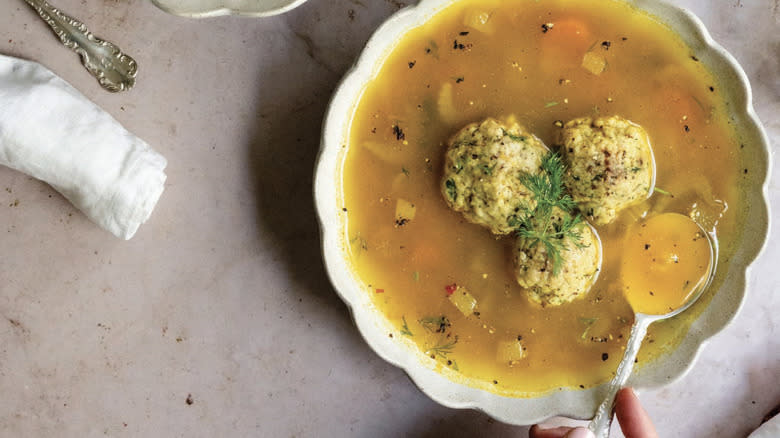
Matzo balls are truly an anytime food. Made from a combination of fat (traditionally schmaltz or rendered chicken fat), egg, and matzo meal, matzo balls are first boiled and then typically served in a comforting broth. They are a huge part of the healing elixir, serving to aid just about every ailment from colds and fevers to heartbreak and homesickness. Matzo ball soup is recognized for its comforting properties both within and outside of Jewish communities. It's also a classic staple of the Ashkenazi Jewish deli and equally present on the table for Jewish holidays from Shabbat to Passover. Depending on when it's served, matzo ball soup can also include other comforting carbs from egg noodles to kreplach, another much-loved dumpling from the Jewish diaspora.
Siva suggests swapping schmaltz for olive oil for those who love these cure-all balls but prefer to avoid using animal fat. She says, "If you didn't know that your standard matzo ball was made with schmaltz (chicken fat), now you do! I use fragrant olive oil in mine -- it gives a golden hue and an interesting, grassy flavor, and makes your favorite matzo ball vegetarian."
Try Flax Seed In Place Of Egg To Keep Your Latkes Together
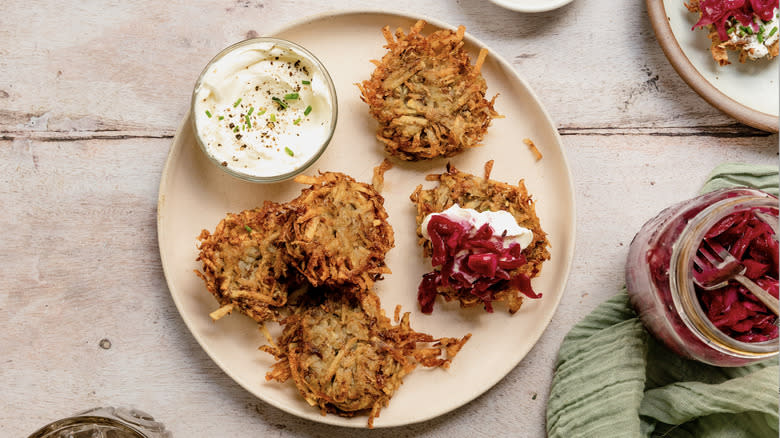
Latkes, typically made with potatoes and onion and bound together with egg, should be an everyday food for their taste alone. However, the labor-intensive act of deep frying, plus the associated health implications, means these delicious fried treats to holidays like Hanukkah, where fried foods of all kinds are traditionally served. If cooking for vegans or looking for vegan egg alternatives, Siva suggests considering flax seed for all your binding needs.
"Flax seeds are a fabulous egg substitute. When ground flax is combined with water, the mixture becomes gelatinous. When you use this to make latkes, it can help absorb the water from potatoes for an extra crispy potato pancake," says Siva.
Siva also adds a whole, trimmed carrot to the oil when frying to help keep the oil fresh by giving the pieces of broken latkes somewhere to cling while infusing them with flavor. She also adds a shake of the much beloved "Everything but the Bagel" seed blend to the final products before serving them alongside vegan sour cream. For those looking to incorporate these flavors into the patties without risking burning the seeds, you can stir them into the batter.
Replace Beef Brisket With Mushroom And Tofu

With Passover around the corner, many Jewish homes will be considering the menu for the ceremonial seder, a symbolic retelling of the book of Exodus, which the holiday is built to commemorate. Traditional dishes served at Passover include matzo balls, gefilte fish, charoset, and brisket, amongst many others. Siva suggests swapping out brisket for more vegetarian-friendly ingredients, including mushrooms and tofu, for those looking to pass over meat-based dishes. Both ingredients lend themselves to rich, umami-packed seasonings, not to mention their substantial meat-like textures. By shredding the mushrooms and grated, extra-firm tofu, then topping both in a sweet-meets-savory sauce, all of the essential components that make brisket so delicious are there.
"Brisket is one of the most beloved Jewish comfort foods," says Siva. "Skip the beef and make a plant-based version this year. Protein-packed mushrooms and tofu make this a filling dish that is just as rich as its beefy counterpart thanks to a healthy dose of olive oil. Using grated tofu makes the texture reminiscent of the crispy brisket edges, and the red wine marinade is based on my grandmother's recipes!"
Swap Out Chicken Schnitzel For Tofu
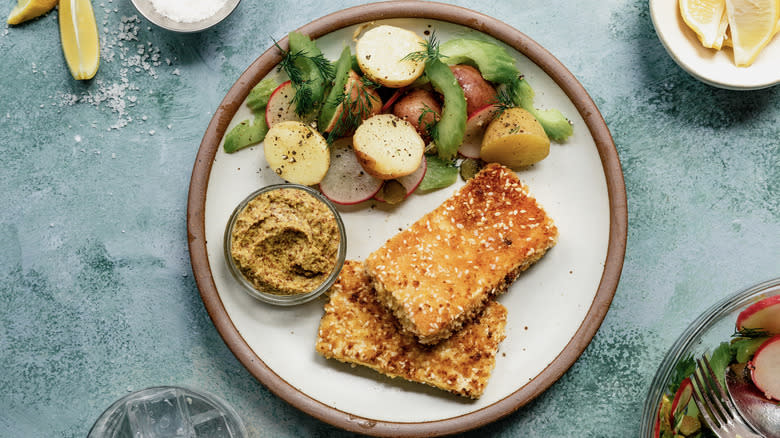
Where would the culinary world be without fried chicken, especially when the cutlets are pounded into thin escalopes like Milanese and schnitzel? Schnitzel, which means "cutlet" in German, originated in Eastern Europe but became popular amongst Jewish communities in Israel, the U.K., and the U.S.. It's hard to resist the crispy texture and juicy center, finished off with a squeeze of lemon or a creamy, tangy dressing. For those looking to eat less meat or to branch out and try new plant-based versions of this incredibly satisfying dish, Siva suggested we turn to tofu, infused with a key ingredient, pickle juice.
She notes, "Chicken schnitzel was a staple in our household growing up. To infuse flavor into extra firm tofu, I brine it in pickle juice, which removes excess moisture, and infuses the tofu from the inside out. The breading is a mixture of panko breadcrumbs and sesame, rivaling the schnitzel of the Tel Aviv markets. I also like to "schnitzel" cauliflower steaks, and you can use matzo meal if preparing during Passover. I like to serve mine with a squeeze of lemon juice."
Use Cauliflower In Place Of Fish To Make Chraime
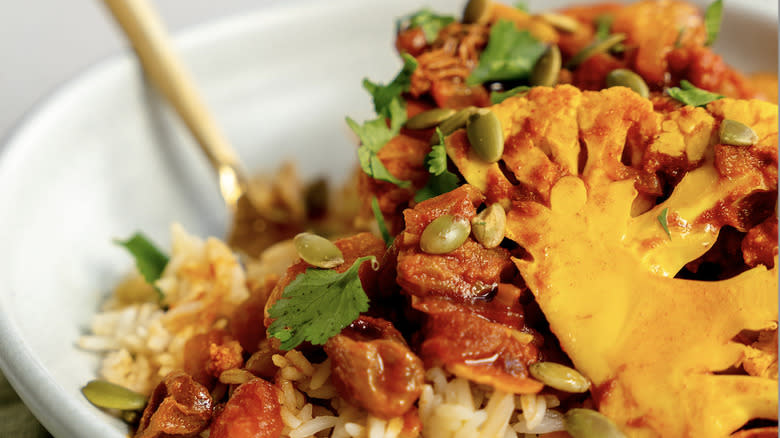
In the last few years, cauliflower has finally begun to get the recognition it deserves. A delicious vegetable and ingredient in its own right, cauliflower is also often used instead of steaks, chicken wings, or other meat-based items to make meat-mimicking vegetarian foods interesting and satisfying. Siva employs the same idea in her recipe for vegan chraime. Chraime is a fish-based stew originally from North Africa, regularly eaten and enjoyed by Sephardic Jewish communities. It is often served during the Jewish high holidays and can also be served weekly for Shabbat.
Siva says, "Chraime is a spicy tomato stew made with white fish. I love the combination of tomato and spices to flavor the fish... but if fish isn't on the table, cauliflower wedges make a great substitute; the cauliflower takes on the flavor (and spices) of the liquid for a flavorful dish that is just another way to use cauliflower! I also add a handful of golden raisins to mine for a bite of sweet flavor, and serve it with couscous, rice, or crusty bread."
Try Tempeh Instead Of Beef In Cholent
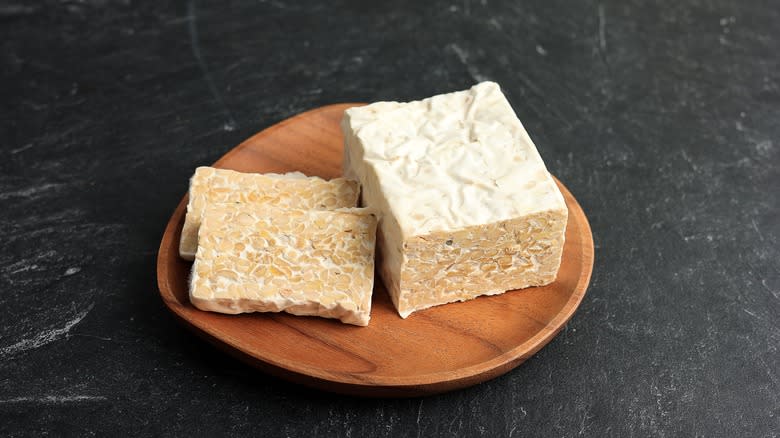
Cholent is a traditional dish originally from Jewish Eastern European communities. It is, essentially, a hearty, slow-cooked stew made from meat, potatoes, and beans. The beauty of cholent is in its taste, its adaptability, and how little attention it needs to taste delicious. The stew is prepared on Friday before sundown when the holiday begins. It then cooks overnight and is eaten as the main meal during Shabbat, the day of rest, when more traditional Jewish laws forbid work, including cooking, from being done. While this has been a meaty affair, it doesn't necessarily have to be that way.
Siva says, "Cholent is typically made with a tough cut of meat and cooked low and slow in time for Shabbat. I like to use "meaty" tempeh, a soy-based protein that originated in Indonesia and is made using fermentation. Packed with protein, tempeh keeps its texture for a hearty sabbath (or any day) dish!"
Sink Your Teeth Into Pastrami-Cured Celery Root In Place Of Beef
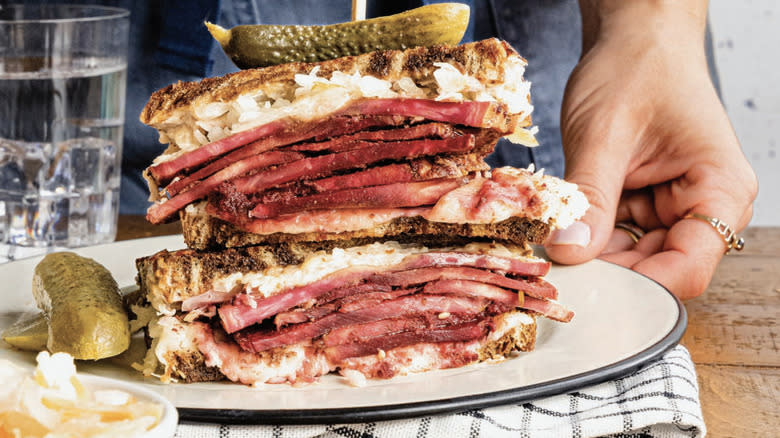
Pastrami has become synonymous with the American Jewish deli. Initially brought to the U.S. by Jewish Romanian immigrants in the 1800s and 1900s, "pastirma," as the dish was known, was made from goose before being adapted to suit American resources and eating customs. Beef soon replaced goose, and this brined, cured, and peppered meat has been a staple across Jewish and non-Jewish delis and households ever since.
As times and trends have evolved, so too has pastrami, with many delis like Larder, in Cleveland serving plant-based alternatives. Siva suggests giving celery root (also known as celeriac) a try for those craving pastrami but looking for a more vegetable-forward alternative that you can make right at home.
She says, "Celery root is one of my favorite vegetables. The base of a celery plant, celery root, or celeriac is slightly sweet with an earthy, nutty flavor. When roasted, sliced, and marinated, it becomes a juicy substitute for pastrami. The secret is a red beet marinade to mimic the color, and a highly spiced rub to ensure that you get those pastrami spices in every bite. Stack it on rye bread with sauerkraut and a mayo-based dressing for a delicious Reuben!"
Braise Chickpeas Instead Of Eggs For Shakshuka
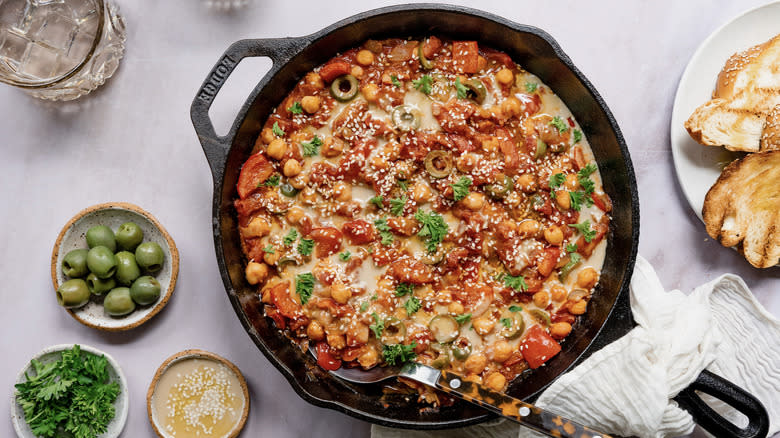
For those in search of an easy, filling, anytime meal, shakshuka, with origins in North Africa and Middle Eastern countries like Yemen, this saucy, spiced, almost stew-like dish is a crowd-pleaser that can be served for breakfast, lunch, dinner, or anywhere in between. Shakshuka is a popular breakfast and brunch menu item, served alongside crusty bread or pita, perfect for dipping and mopping up any remaining sauce. There are several varieties, too, from the classic spiced tomato-based dish to a green version that uses spinach and generous helpings of herbs.
Rather than using eggs, which are then poached in the tomato sauce, Siva suggests replacing them with a plant-based protein, like chickpeas. She says, "Shakshuka is a delicious, tomato-based stew with poached eggs, but if you don't eat eggs, you can still enjoy shakshuka. Simply add a can of chickpeas to your braising liquid, and enjoy with a fluffy, warm pita and a drizzle of rich tahini."
Tuck Into Za'atar And Vegan Feta Khachapuri Instead Of Egg And Cheese

Khachapuri is the irresistible diamond-shaped pastry that is considered the national dish of Georgia (the country, not the state). This savory pastry often contains a well of eggs but can also have a variety of other toppings, which are all smothered with perfectly melted, bubbling cheese. Khachapuri can be served at any time of day, from breakfast to dinner. The country's capital city, Retro, is known for its sakhachapures, or khachapuri cafes.
Unsurprisingly, perhaps, given both its taste, the location of its origins, and its adaptability to be kept kosher if needed, this delicious pastry has made its way into the culinary offerings of many Jewish communities, including the small Georgian Jewish diaspora, and can be easily found in the Israeli food scene.
Though this anytime pastry is known for its cheesy appeal, Siva thinks it can taste just as good without it, and her cookbook provides vegan and vegetarian options. She says, "Khachapuri is a Georgian/Armenian dish often found in Jewish cuisine. It is typically laden with dairy and topped with a runny egg. To make it vegan, stuff it with your favorite vegan cheese, or my personal favorite, tofu-feta, and a healthy dose of za'atar."
Replace Eggs And Butter With Tahini And Olive Oil For Challah
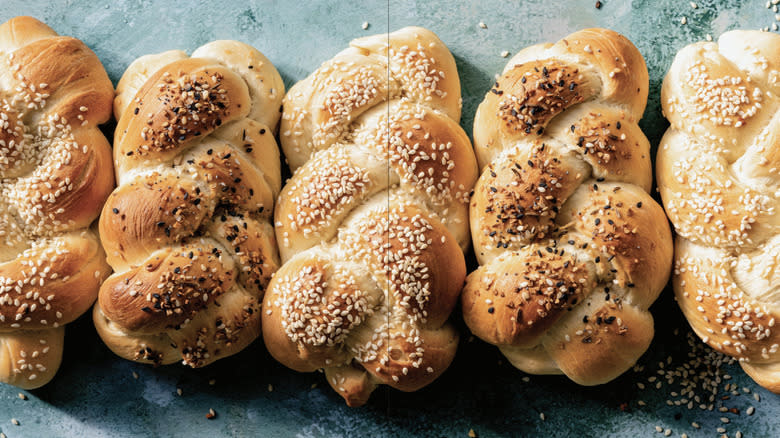
There's nothing quite as comforting or reassuring as challah. The yeasty scent that fills the room when baking your own at home, the satisfying experience of rolling and braiding it in three or six strands, and even just seeing freshly baked loaves lined up on the shelves of the local Jewish bakery elicits a sense of calm and ease. In most Jewish communities, challah is present at celebrations and on the weekly Friday Shabbat dinner table. This egg-rich dough can be challenging to navigate for those who have decided not to consume any animal products. But Sivo has a solution, which she presents in the book.
She tells us, "Many challahs contain eggs, so to replace the richness of a yolk and the moisture of an egg, I use tahini, or ground sesame, for a rich challah with a slight nutty flavor. Tahini makes vegan challah just as hearty and deliciously dense as its egg-containing recipes."
Make Your Own Vegan Egg Cream Without Cow's Milk
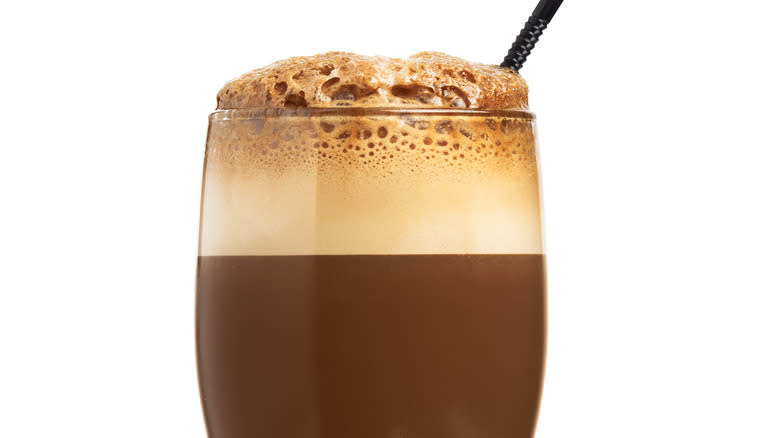
"I love egg creams -- but they don't love me," says Siva. These sweet, carbonated beverages are an old-school throwback to the early days of New York's Jewish deli, a classic drink still on the menus of many Jewish American delis. Though their true origins remain a mystery, potentially having been brought over from France or Ukraine, they are delicious but equally remain something of an acquired taste. Considered slightly peculiar for those who haven't had them before, the name also sends mixed messages, considering there isn't egg or cream in the drinks, but full-fat milk mixed with soda water and chocolate syrup.
For those whose bodies feel the same way about milk as Siva's, she has a solution. She says, "In place of milk I use a nondairy creamer for a dairy-free egg cream. Want to make your own chocolate syrup? Use a mixture of maple syrup, cocoa powder, vanilla, and a pinch of sea salt for a naturally sweet egg cream."
Read the original article on Tasting Table

